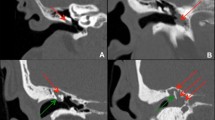Abstract
Cholesteatoma is probably one of the very few conditions in the body with as many controversies regarding its name, definition, genesis and pathology. It is essentially a benign tumour, which pushes away the middle ear cleft mucosa and any tissues that get in its way. The indisputable starting point is the presence of an inflammatory process of the upper airways and the middle ear cleft mucosa. The growth pattern of the cholesteatoma is dictated by the site of origin and the most common sites are the pars flaccida and the postero-superior quadrant of the pars tensa. The diagnosis of cholesteatoma is essentially clinical and treatment is surgical wherein the primary aim of surgery is to provide a disease free dry ear. However, keeping with the changing clinical profile of patients presenting with cholesteatoma, it is important to also aim at a functionally better ear.



Similar content being viewed by others
References
Bernard MPJ (1999) Pathogenesis of acquired cholesteatoma. In: Ars B (ed) Pathogenesis of cholesteatoma. Kugler Publications, Amsterdam, pp 6–15
Author information
Authors and Affiliations
Corresponding author
Rights and permissions
About this article
Cite this article
Pusalkar, A.G. Cholesteatoma and Its Management. Indian J Otolaryngol Head Neck Surg 67, 201–204 (2015). https://doi.org/10.1007/s12070-015-0891-y
Received:
Accepted:
Published:
Issue Date:
DOI: https://doi.org/10.1007/s12070-015-0891-y




